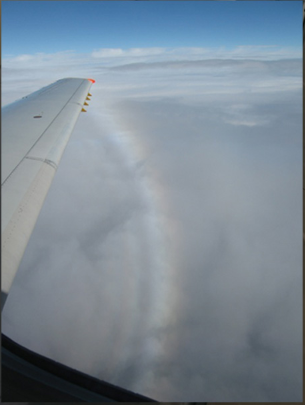Vertical rainbows
Vertical Rainbows: A Phenomenon Worth Noticing
Rainbows have always fascinated us with their vibrant colors and graceful arcs stretching across the sky. But have you ever heard of vertical rainbows? Yes, you read that right! Vertical rainbows are a rare and captivating atmospheric optics phenomenon that deviates from the usual horizontal formation we are accustomed to. In this article, we will delve deeper into the intriguing world of vertical rainbows and explore the science behind their formation.
Vertical rainbows, as experienced by Mark McCaughrean during his descent into Frankfurt, Germany, present a peculiar sight. While traditional rainbows extend horizontally, these vertical counterparts appear to stretch upwards and over the observer. McCaughrean's description of the rainbows as "odd" is an understatement, as vertical rainbows are indeed a rarity to behold.
The formation of vertical rainbows is closely linked to the interaction between sunlight, rain, and clouds. As sunlight passes through raindrops or cloud droplets, it undergoes a process known as refraction. This bending of light causes the different colors within white light to separate and form a spectrum. Normally, this spectrum forms a circular arc in the sky, resulting in a horizontal rainbow. However, certain atmospheric conditions can give rise to vertical rainbows.
One factor influencing the formation of vertical rainbows is the size of the water droplets present in the atmosphere. Raindrops, with diameters upwards of 1mm, diffract light but to a lesser extent compared to smaller cloud droplets. Cloud droplets, which are 10 to 1000 times smaller than raindrops, strongly diffract light, causing the rainbow to spread out and the colors to become diluted. This diffraction effect is more pronounced in vertical rainbows, giving them their distinct appearance.
It's important to note that the visibility and intensity of vertical rainbows can vary depending on several factors, including the angle of the sunlight, the density of the rain or cloud cover, and the observer's position relative to the rainbow. These variables contribute to the uniqueness and elusiveness of vertical rainbows, making them a rare treat for those fortunate enough to witness them.
The colors of vertical rainbows can also differ from traditional rainbows. While traditional rainbows exhibit strong saturated colors, vertical rainbows often display pastel shades in wide diffuse bows. This variation in color intensity can be attributed to the diffraction and scattering of light by the smaller cloud droplets. The result is a softer and more ethereal color palette that adds to the enchantment of vertical rainbows.
Although vertical rainbows are relatively uncommon, they are not impossible to capture on camera. However, as Mark McCaughrean discovered, capturing the full extent of a vertical rainbow can be challenging due to the limited field of view of most phone cameras. To fully appreciate the awe-inspiring beauty of vertical rainbows, one must witness them firsthand and allow themselves to be immersed in the magical atmosphere they create.
In conclusion, vertical rainbows are a captivating phenomenon that deviates from the traditional horizontal formation we associate with rainbows. Their rarity and distinct appearance make them a spectacle worth noticing and cherishing. Understanding the science behind their formation adds to our appreciation of the intricate interplay between sunlight, raindrops, and cloud droplets. So, keep your eyes to the sky and be prepared to be amazed by the wonders of nature, including the elusive vertical rainbows that may grace our atmosphere from time to time.

Vertical rainbows
Rainbows brightened Mark McCaughrean�s descent into Frankfurt, Germany. It was 30 minutes before sunset as the aircraft descended through strong showers.
�The rainbows extended further up and over, as you might expect, but it was not possible to capture the full extent with the FOV of my phone's camera.
The yellowish cast comes because the sunlight was diffusing through the rain and cloud on the horizon.
Very strong saturated colours in the rainbows and a strong Alexander's dark band. Odd to see the rainbows vertical though!�
Image ©Mark McCaughrean, shown with permission

A cloudbow with an outer secondary bow by Eva Seidenfaden (Paraselene). Compare with the above, lower altitude, scene. Narrow bows and saturated colours are replaced by wide diffuse bows of sparse pastel shades.
Water drop size makes all the difference. Raindrops are upwards of 1mm diameter. Cloud droplets are 10 to 1000X smaller. The smaller droplets diffract light strongly spreading the rainbow and diluting colours. Raindrops diffract also but the effect on rainbows is less.
Note: this article has been automatically converted from the old site and may not appear as intended. You can find the original article here.
Reference Atmospheric Optics
If you use any of the definitions, information, or data presented on Atmospheric Optics, please copy the link or reference below to properly credit us as the reference source. Thank you!
-
<a href="https://atoptics.co.uk/blog/vertical-rainbows/">Vertical rainbows </a>
-
"Vertical rainbows ". Atmospheric Optics. Accessed on November 26, 2024. https://atoptics.co.uk/blog/vertical-rainbows/.
-
"Vertical rainbows ". Atmospheric Optics, https://atoptics.co.uk/blog/vertical-rainbows/. Accessed 26 November, 2024
-
Vertical rainbows . Atmospheric Optics. Retrieved from https://atoptics.co.uk/blog/vertical-rainbows/.